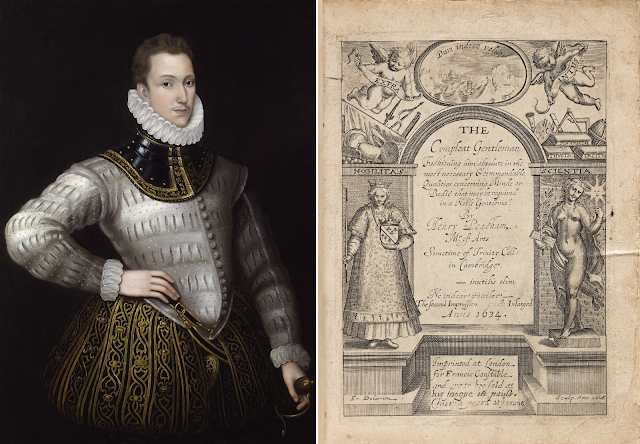Jewel of Her Crown
 |
Left: Sir Philip Sidney (18th century copy of a c. 1578 original) after Antonis Mor; Right: Henry Peacham's The Compleat Gentleman (Francis Constable, London, 1634) |
In the course of the history of English letters certain authors disengage themselves who have more than a merely literary position: they are symbolic of the whole age in which they live, its life and action, its thoughts and ideals, as well as its mere modes of writing. There are not many of them and they could be easily numbered: Addison, perhaps, certainly Dr. Johnson, certainly Byron, and in the later age probably Tennyson. But the greatest of them all is Sir Philip Sidney: his symbolical relation to the time in which he lived was realized by his contemporaries, and it has been a commonplace of history and criticism ever since. Elizabeth called him one of the jewels of her crown, and at the age of twenty-three, so fast did genius ripen in that summer time of the Renaissance, William the Silent could speak of him as “one of the ripest statesmen of the age.” He travelled widely in Europe, knew many languages, and dreamed of adventure in America and on the high seas. In a court of brilliant figures, his was the most dazzling, and his death at Zutphen only served to intensify the halo of romance which had gathered round his name.
His literary exercises were various... It is his other great work, the sequence of sonnets entitled Astrophel and Stella, which concerns us here. They celebrate the history of his love for Penelope Devereux, sister of the Earl of Essex, a love brought to disaster by the intervention of Queen Elizabeth with whom he had quarrelled. As poetry they mark an epoch. They are the first direct expression of an intimate and personal experience in English literature, struck off in the white heat of passion, and though they are coloured at times with that over-fantastic imagery which is at once a characteristic fault and excellence of the writing of the time, they never lose the one merit above all others of lyric poetry, the merit of sincerity. The note is struck with certainty and power in the first sonnet of the series:—
Loving in truth, and fain in verse my love to show,
That she, dear she, might take some pleasure of my pain,—
Pleasure might cause her read, reading might make her know,—Knowledge might pity win, and pity grace obtain,—
I sought fit words to paint the blackest face of woe,
Studying inventions fine her wits to entertain;
Oft turning others' leaves to see if thence would flow
Some fresh and fruitful flower upon my sunburned brain.
But words came halting forth...
Biting my truant pen, beating myself for spite.
“Fool,” said my muse to me, “look in thy heart and write.”
And though he turned others' leaves [1] it was quite literally looking in his heart that he wrote. He analyses the sequence of his feelings with a vividness and minuteness which assure us of their truth.
English Literature, Modern, 1450-1939
Notes:
- Refers to Italian and French literary models, not just in the form (petrarchan sonnet), but also in their imagery and expression.
Comments
Post a Comment